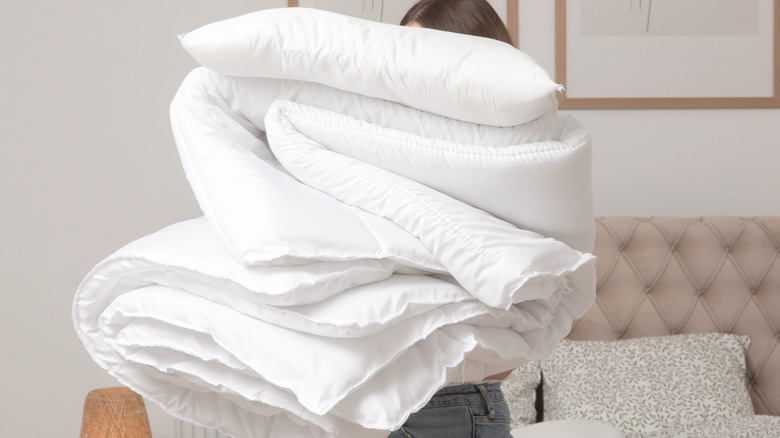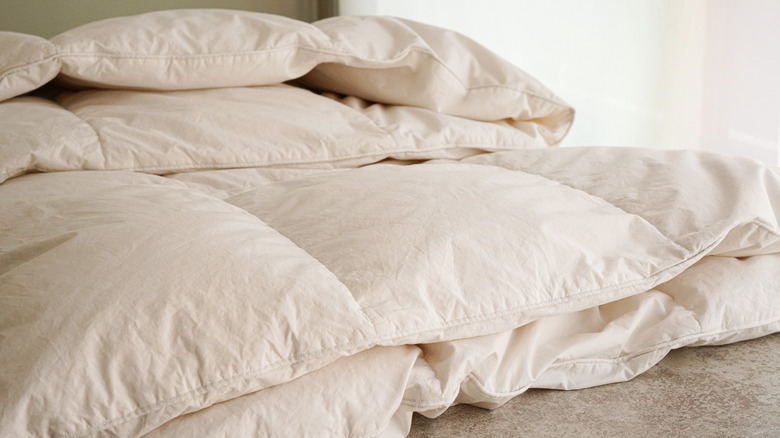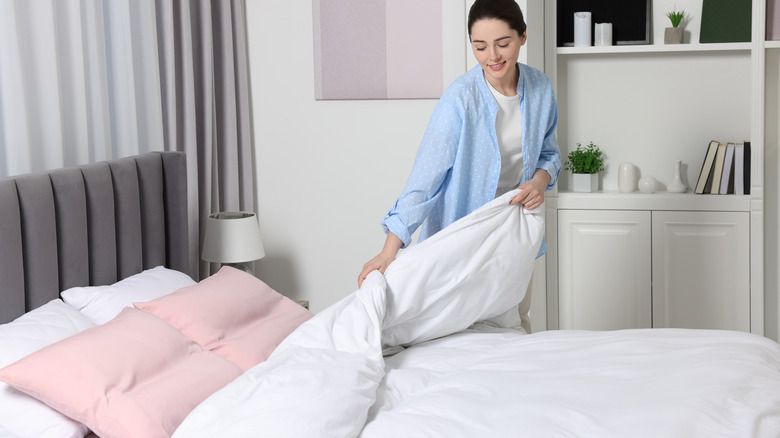Here Are The Pros And Cons Of A Down Alternative Comforter
We may receive a commission on purchases made from links.
Thinking about giving your bedroom a makeover? Whether you're itching to refresh your bedding for a new season or just amp the snuggle factor, the myriad of choices can feel overwhelming. But if you're hunting for that sweet spot between budget-friendly and comfort, let us nudge you toward a gem: down alternative comforter. Hypoallergenic, a breeze to wash, and easy on your wallet, these bed toppers are crafted to mimic the plush feel of real down minus the downsides (pun intended). But even the sun has its spots. These gems may not always bring the same luxury level of softness as real down. Plus, they've got this not-so-fun trait of not being breathable.
About down vs. down alternative comforters, the former uses a fluffy undercoat from duck and geese, while the latter swings more toward synthetic materials like microfiber, polyester, or fancy names like PrimaLoft. Shopping for a down alternative comforter? Lean more toward a lighter option if you're the type that gets pretty warm at night. If you're on the cooler side, go for a bit more heft. For the exterior fabric, you're better off with natural materials — cotton reigns supreme, but silk, bamboo, and lyocell are also great. As for how it's all held together, you've got sewn-through, where the top and bottom are stitched together to keep the fill right where it should be. Alternatively, the baffle box kind uses a bit of fabric to separate the layers of fill, making for a warmer and loftier comforter.
Pros of a down alternative comforter: Affordable and hypoallergenic
Down alternative comforters hit a sweet spot in the bedding market thanks to their synthetic content that cuts down on production expenses, translating into a lighter load on your finances. For example, the king-size Peace Nest All Season White Down Comforter will set you back $240 at Target. Now, flip the script to the king-size Bare Home Goose Down Alternative Comforter going for $67 — it's a sweet deal that leaves you with plenty of extra cash to splurge on those extra comforts like pillows. The hypoallergenic nature of down alternatives is absolute gold. By resisting the clutches of dust mites and other allergy culprits, these comforters are the perfect sidekicks for anyone with asthma or those prone to sinus dramas. Plus, for those treading on the ethical edge, these comforters score major points — not a single feather gets ruffled in their making, meaning the conscious consumers can walk the path to comfort guilt-free.
Another benefit of down alternative comforters is that they are triumphantly easy to maintain. A cycle of a washing machine and a low-heat tumble are all you need. And by cleaning your down alternative comforter regularly, you're also keeping dust and allergens at bay. That's a notable leap from the fuss that comes with traditional downs, which typically beg for professional dry cleaning. Just a little tip: stick to the care tag instructions to keep your down alternative comforter looking and feeling awesome for the long haul.
The downsides to a down alternative comforter
Down alternative comforters are sneaking up the popularity ladder, but they haven't quite reached the pinnacle where they match the plushiness of real down. You might get the impression of a fluffy contender, but the moment you first dive under one, there's a giveaway. The texture still trails behind the smooth, luxurious caress of genuine down feathers. Another disadvantage of down alternative comforters boils down to weight. To match the insulation level of down, they often need more filling (almost double the amount). Now, that does come with a slight hitch — a bit more heft. If you're accustomed to snuggling under a light but warm blanket, this can be a bit of a surprise. For those in cold areas, a hefty down alternative could be a win, but if you're living where heat seemingly doesn't quit, you could find the extra fill to be more than you bargained for.
Another thing: if you're diving into a down alternative with dreams of a cool, breathable night, you might want to dial back those expectations a tad. Naturally, when a material's breathability is less, it's not a champ at wicking away moisture. So, you might be signing up for some warm, sticky nights. However, if you're all about snuggling under that downy softness on a budget, these drawbacks of a down alternative comforter might just be minor hurdles you can navigate around. After all, there are plenty of hacks to freshen up your comforter.


